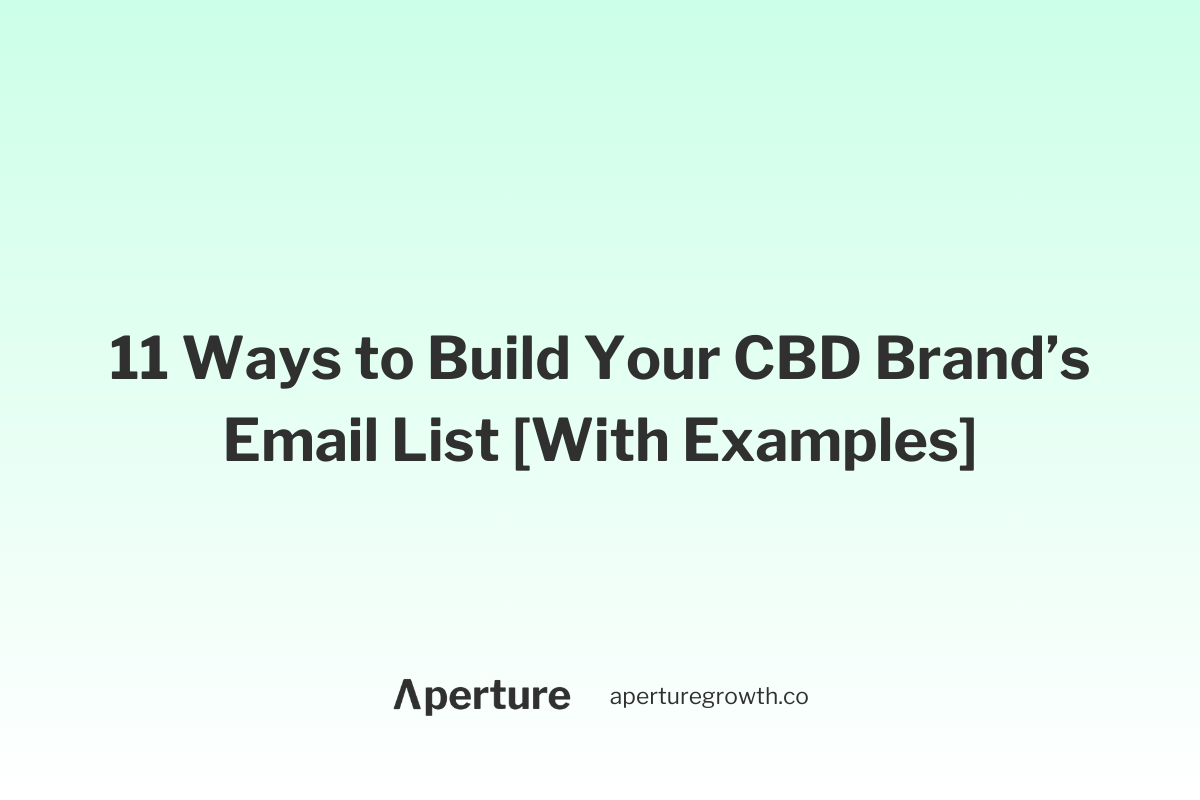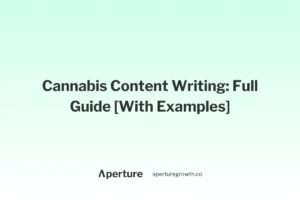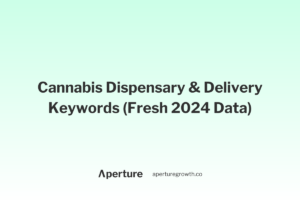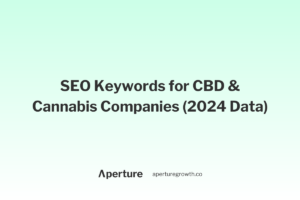I always see people talk about why email marketing is beneficial for CBD brands (and believe me, it is), and I always see people talk about how to craft high-converting campaigns and flows.
But I don’t see enough people talk about how to build a list of people to send emails to.
And in the beginning, that’s the hardest part: building a list of people who actually care about your company and would be interested in buying your products or, at the very least, reading your emails.
So to help you, in this article, I’m going to lay out 11 different ways you can grow your brand’s email list. I’ll also be including an example for each from a brand just like yours.
Why Build an Email List for Your CBD Brand?
If you clicked on this article, chances are, you already know why email marketing is beneficial for your brand – and for CBD companies in general.
But in case you don’t, here are the high-level business benefits of building and monetizing an email list:
- You can convert people who are on the fence: One of the biggest benefits of email marketing is that it allows you to nurture potential customers who may not be 100% sold on the benefits of CBD. The pool of people who are willing to learn more is far larger than the pool ready to buy right now, and email allows you a chance to access this segment of people.
- You can retain customers more easily: You’ll have a very hard time growing your brand unless you retain your existing customer base in addition to acquiring new customers. Email allows you to do just that; you can collect emails from every person who buys from you, then send them content to keep them engaged with your brand and drive future purchases.
- You’ll have a consistent revenue-generating channel: If you build your email list to a certain size and send targeted emails on a regular basis, you can drive revenue with some regularity. There’s nothing better.
- You can develop deep trust with consumers: Because email allows you to continuously connect with your customers, it allows you to assume a place of regularity in your customers’ lives and builds their trust in your brand over time. This can increase average order value, and can allow you to sell CBD subscriptions and other higher-commitment offerings because your customers will now trust your brand more.
- You own the audience: There’s a lot of hype around email because you “own” your audience, but honestly, it’s justified. When you send an email, it reaches close to 100% (not exactly 100% due to deliverability issues) of the people on your list or in your chosen segment. You decide who sees what, and when – you’re not at the whim of another platform’s rules, policies, or algorithms. This is especially important in restricted industries, which Meta and Google are known to be hard on (just make sure you pick a platform that allows CBD marketing, such as Klaviyo).
Email marketing is absolutely mandatory for any CBD business, whether local-only, e-commerce only, local-online hybrid, B2C, or B2B. You name it.
We don’t say this because we offer email marketing services (we don’t), we say it because it’s true.
Steps to A Successful List-Building Campaign for Your CBD Brand
Before I get into the list tactics, I’m going to cover a brief process you can use for any list-building motion you undertake for your brand.
This isn’t a process you need to formalize and follow to the letter, but it can help you design list-building efforts that get the best returns.
1. Set a goal
The two most common reasons CBD brands build email lists and send emails to them are:
- Drive more revenue: Certain types of list building and email marketing directly focus on driving orders and repeat orders.
- Bring more people into your ecosystem: Some list-building efforts are done purely to introduce people to your brand, educate them, and bring them into your sphere of influence. Given the knowledge gap between companies and consumers in the CBD space, this type of email marketing is often required.
Both of these goals should be pursued, but it’s important to understand which goal you’re focused on when designing a list-building campaign, because different tactics work best for different goals. Strategy before tactics, always.
2. Create an offer
Once you know who you’re trying to get on your list and why, you need to come up with an offer.
This offer needs to do two things:
- Give people a reason to sign up for your email list.
- Act as a filter so that the people who sign up for your email list are necessarily in your target audience (or are a close fit).
#1 is intuitive. But #2 isn’t, always.
To make this more concrete, think about the practice of giving people discounts in exchange for signing up for your email list: that offer is only desirable – and therefore people will only take it and sign up – if they have some intention of purchasing your products, no matter how small.
3. Create a form or landing page
Once you know why you’re running a particular list building effort and have a good offer in mind, you’ll need to create a form – which will usually live on a landing page or be built into a page(s) on your site – to capture names and emails.
Most platforms (again, I recommend Klaviyo for CBD brands) offer form-building functionality.
4. Execute list-building strategies
With the steps above out of the way, it’s now time to select and execute the appropriate list-building tactic(s).
List-building tactics vary in effectiveness; the most important thing is that you choose a tactic that makes sense for your offer and goals.
Email List Building Tactics for CBD Brands
Here are 11 ways to build your CBD brand’s email list, plus, examples of brands like yours executing these tactics:
1. Install a pop-up form on your site
You can install a pop-up form that shows for every new website visitor, but doesn’t show for repeat visitors. It’s a simple, effective way to drive email signups from the traffic you’re already getting.
I recommend the following:
- Make the offer a first-purchase discount between 10 and 25 percent
- Set the form to show 5-10 seconds after the visitor lands on your site
While it can’t be generalized to every brand, we see conversion rates for this type of form hover around 1% for blog readers (most of whom will land on your site from organic search with the intent to learn, not buy) and 5% for visitors who landed on or loaded another type of page.
Binoid does this beatifully with their pop-up form by offering a 15% discount, backing it up by three more benefits, and including a photo for social proof:
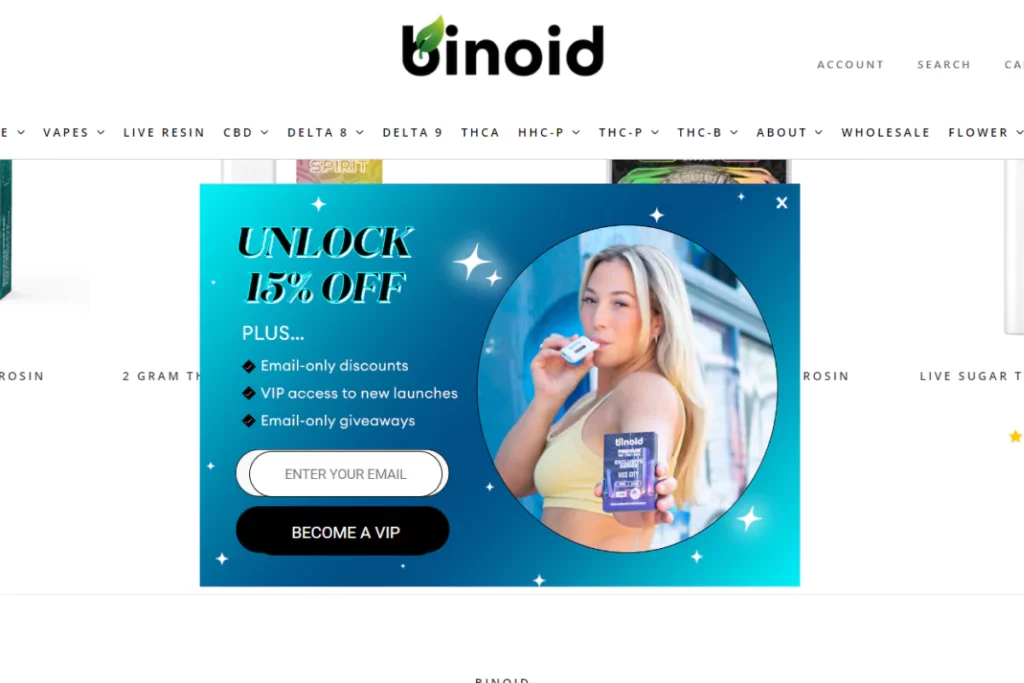
2. Install static signup forms on your site
While pop-up forms are the most effective type of email signup form (because they force the user to acknowledge them) static forms may also collect signups from residual traffic, albeit with a lower conversion rate.
Just as with pop-ups, I recommend using a discount as the offer.
Jupiter’s light and beautiful static form is a great example:
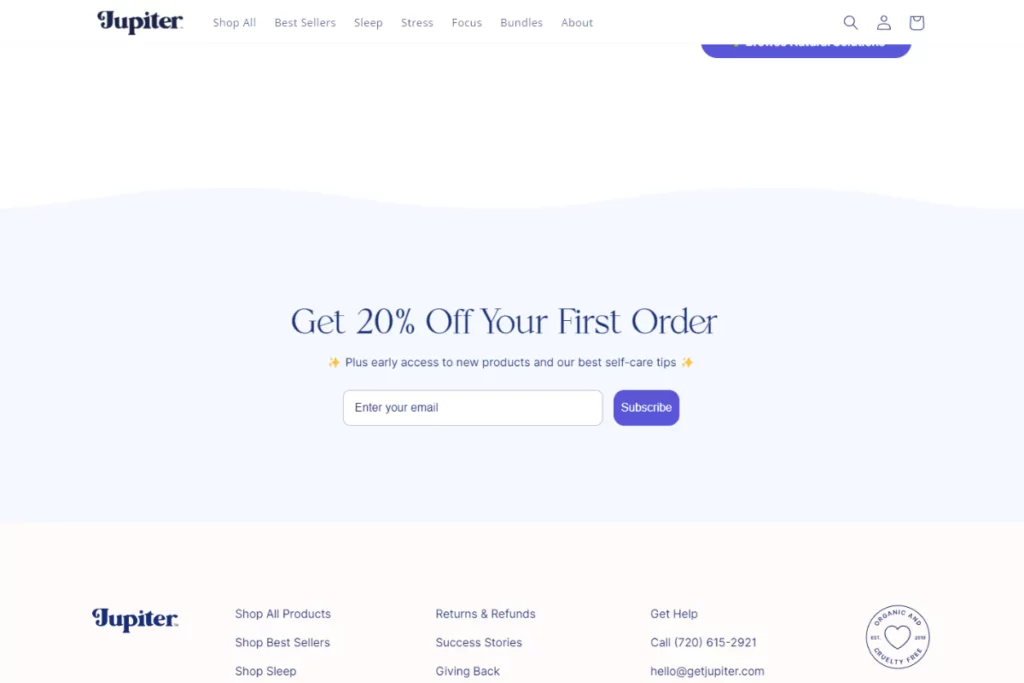
3. Do SEO
Learn how we used SEO to drive over 1,800 email signups in 10 months for a CBD brand in this CBD SEO case study.
Optimizing your category and product pages for SEO, as well as creating high-quality SEO-optimized blog content on a consistent schedule, allows you to drive large amounts of organic traffic.
Ideally, the foremost benefit of SEO is its ability to drive purchases from people as soon as they find your site. But recall that many people simply aren’t ready to buy, and those who land on your site organically are no exception.
The good news is that many of these people will sign up for your email list if you place pop-up and static forms on your site.
Just ask our clients, some of whom are receiving more than 250 email subscribers every month from their blog alone: SEO is an extremely effective way to predictably acquire new email subscribers.
Neurogan receives thousands of visitors every month to their blog, and each new visitor is met by an elegant pop-up form with a discount offer:
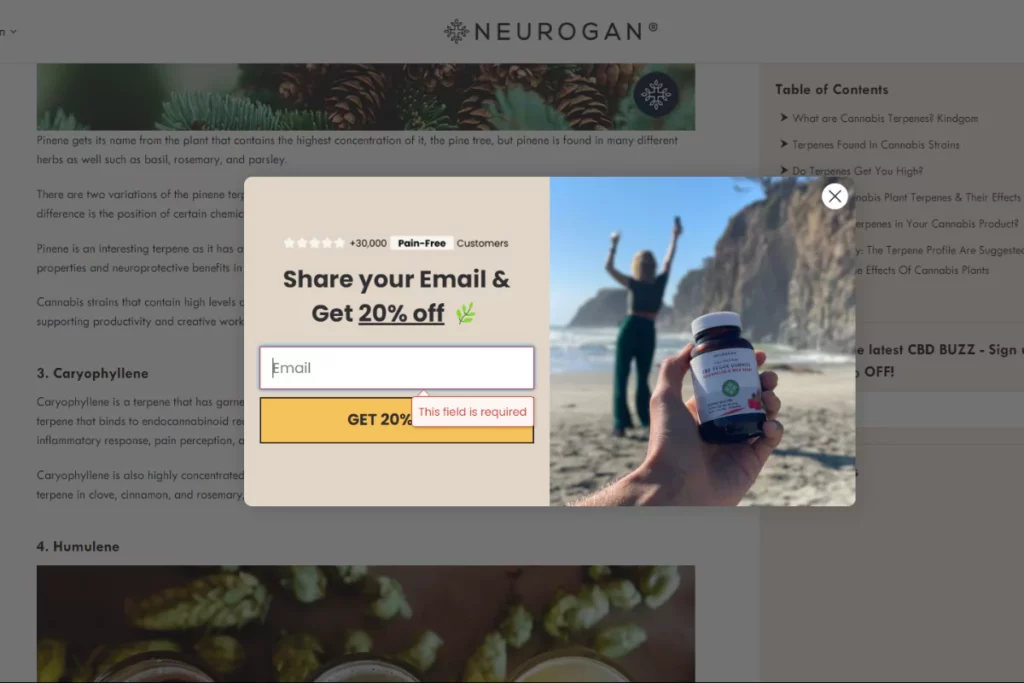
4. Add an opt-in on checkout
One way you can extract more email list growth from the business you’re already getting is to add an option for customers to opt into marketing emails when they check out.
Now, obviously, you can opt users in automatically, and most companies do. But you may prefer to give people the option as to whether or not they want to receive emails.
If you are going to use automatic opt-ins, people usually won’t have an issue with your emails as long as you don’t send too many (and the unsubscribe option is easy to see/use).
Sunday Scaries uses a permission-based opt-in on their checkout screen:
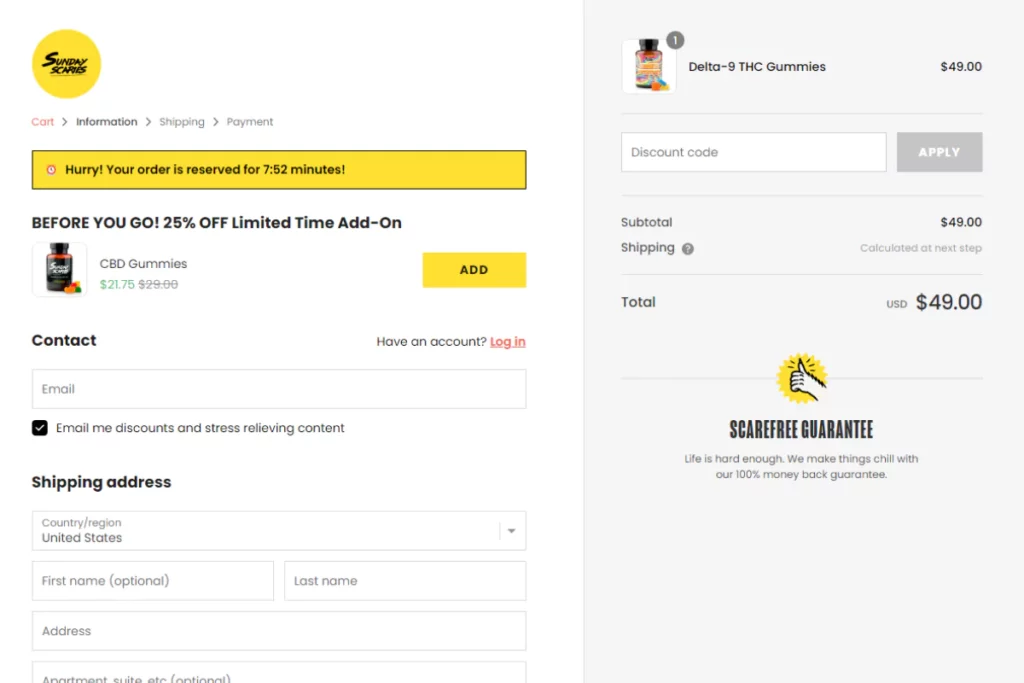
Design a giveaway – a product, or multiple – and advertise it on your social media channels. Then, require people to sign up for your email list in order to enter it.
This is also a good way to grow your social media following and increase engagement.
If you’re giving away a product for free that would otherwise be $60, most people are willing to…
- Like the post
- Share the post
- Follow your account
…in addition to giving you their email.
Casper’s Oil ran a giveaway that included a newsletter sign-up as part of the entry requirements:
6. Run a contest
In the same vein as social media giveaways, design a contest with a product as the prize that involves people giving you their email.
And again, it’s a good way to get people to engage with your social media channels, too.
In addition to the obvious (asking people to submit their information and/or complete certain engagements), some ideas for contests include:
- Taking a quiz
- Guessing the number of CBD gummies in a jar
- Captioning a post
- Taking a photo and posting it with a branded hashtag
The ideas are endless.
Bison Botanics partnered with other companies to run a giveaway that required an email address to enter:
7. Create a quiz
Create a product quiz wherein people reveal their preferences through a series of questions, and then are recommended the product from your selection that is the best fit for them.
At the end, offer them a nice discount on the product in exchange for giving you their email.
Lake Country Growers prompts users to take a product quiz, which ends in an email signup in exchange for a gift:
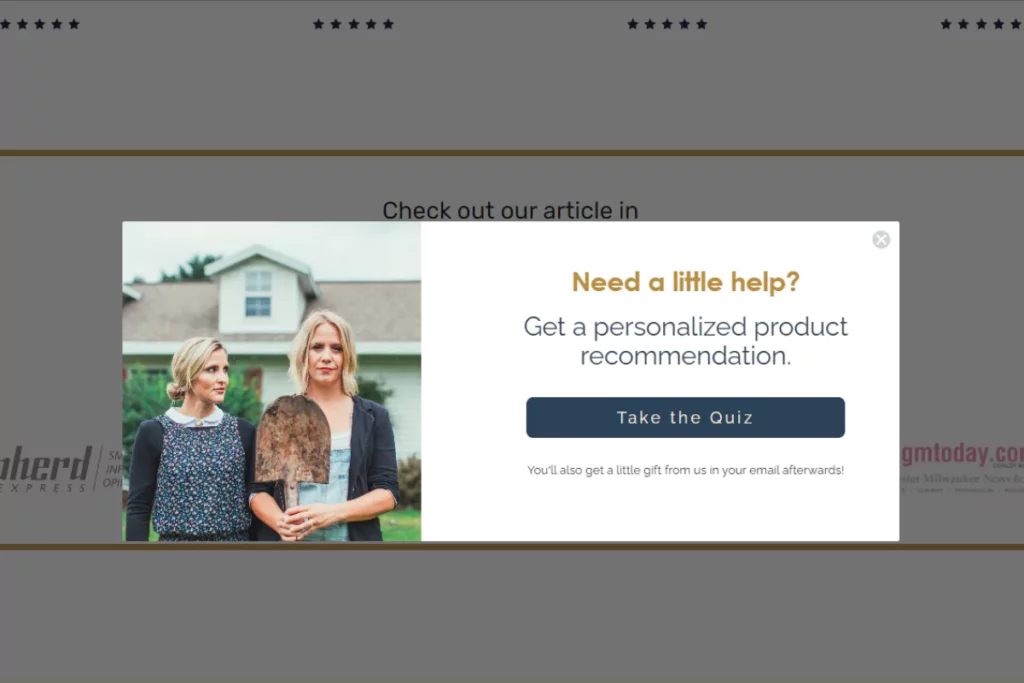
8. Run & advertise email-only specials
Run specials (weekly, monthly, or whatever suits your budget and/or brand goals) that are only offered to your email list. Then, mention these specials on your social media channels:
- Tell your followers what next week’s special will be, then tell them to sign up before the email goes out in order to receive the coupon code
- After a special has already happened, create FOMO by telling your followers what the special was and that they should sign up so they don’t miss the next one
As a word of caution, you’ll want to use FOMO tactics like the latter sparingly. Now and then, they can be effective, but if you overuse them, your brand might take on an antagonistic persona that doesn’t engender trust with your potential customers.
lost range. CBD ran an email-only 60% sale on their CBD tinctures:
If you regularly send discounts, educational content, or other valuables, mention your email list on social media and ask people to sign up.
As with your pop-up forms, this works best if you attach an offer (like a coupon) to the ask.
Harbor Hemp Company advertises their email list on their socials by mentioning the 30% off discount they offer new subscribers:
10. Create a referral program
If you have an existing email list, create a referral program where your subscribers each get a shareable signup link. When they share this link with someone else and that person subscribes, they get a reward from your company (coupon codes are good here). Most major email platforms offer something like this.
The downside of referral programs is that the subscribers they net you may or may not be interested in your products because all they’re being asked to do is sign up for emails, not buy from you.
Referral programs are most effective if you’re building a list that you’re primarily trying to educate, rather than sell to.
Cornbread Hemp’s referral program gives $20 in store credit for each referral, and gives the person you referred them to $20 off their first order over $70:
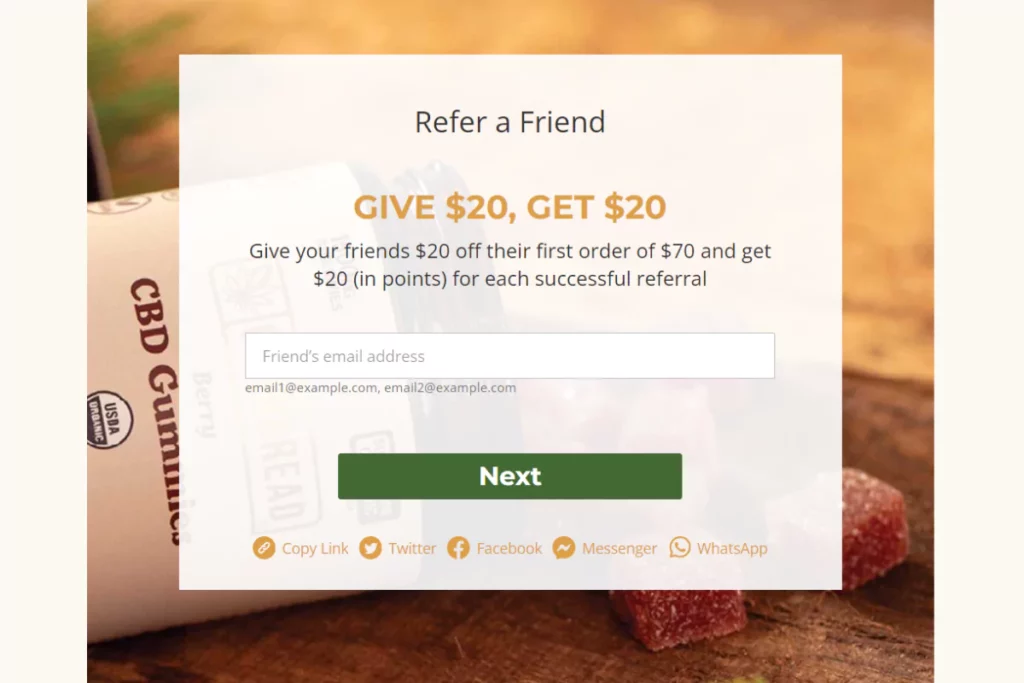
11. Create & promote a lead magnet
A lead magnet is a piece of content that you offer to people in exchange for signing up for your email list.
Per their name, lead magnets are used primarily by B2B companies. In B2B, companies aren’t selling products – they’re selling insights and capabilities. Therefore, content is uniquely valuable due to the information it holds and can easily demand an email signup to be viewed.
But in the CBD space, and e-commerce, generally, lead magnets don’t work quite as well because the information you’re sharing in your content isn’t as exclusive.
But they can still work if you’ve got unique and valuable information that people want. To get good information for a lead magnet, you can:
- Survey your customer base about their preferences for things CBD-related and not, then create a document that summarizes the survey and includes interesting facts
- Write an in-depth eBook about CBD or a related topic
- Write a lead magnet with information not related to CBD, but that your target audience wants (e.g. if you’re a California-based CBD store and dispensary, you could create a lead magnet about the 10 best underground nightclubs)
Lead magnets aren’t the right move for many CBD brands, but they can work in certain circumstances; keep them on your radar.
One benefit of lead magnets is that if you land on a really good idea and create something valuable, you’ll never have to do it again. It can drive new email signups for years to come.
Bailey’s CBD attracts email signups with their CBD for Dogs eBook:
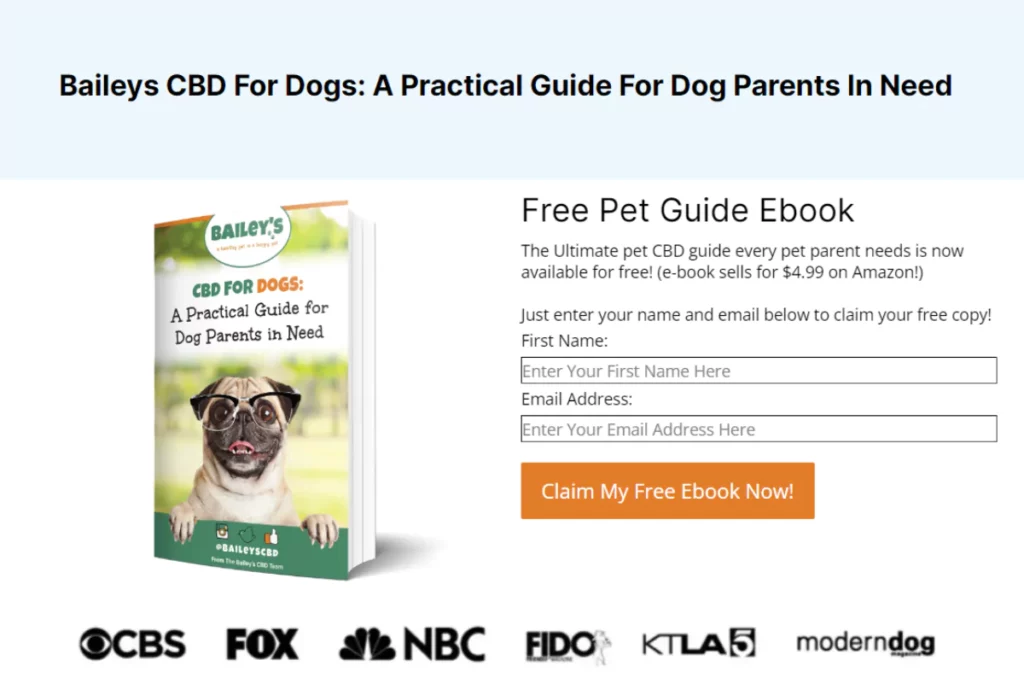
Conclusion: How to Grow Your Email List… And Your Customer Base
As with driving traffic for your CBD brand, email list building isn’t just about acquiring email signups: it’s about getting signups from the right people, such that these people eventually convert to customers.
Here are a few final tips to help you engage in effective email list building:
- Choose offers that only appeal to people with buying intent, such as product discounts
- Make sure that once people opt in to your email list, the content they receive is relevant to their interest (e.g. people who opted in on a buying-intent offer receive promotional emails, those who opted-in on an educational lead magnet are warmed up first with introductory and educational emails)
- Don’t send too many emails, too fast, to new subscribers; you don’t want to scare away new subscribers by spamming them with emails
And that’s it. Best of luck and, as always, feel free to reach out to me on LinkedIn or X if you have any questions or need any help.
Learn More About Our Agency
- Our Services: We drive revenue compliantly for brands in the CBD, Cannabis, Functional Mushroom, and other natural wellness verticals using SEO.
- Our Blog: A collection of in-depth, experience-based articles on SEO and marketing in restricted verticals.
- Our YouTube Channel: Weekly videos covering SEO, marketing, and growth for natural wellness businesses.

